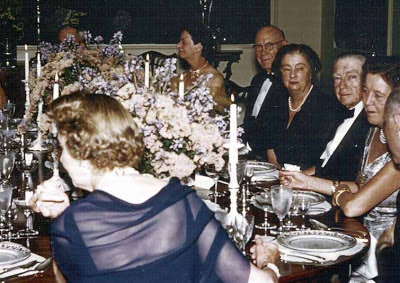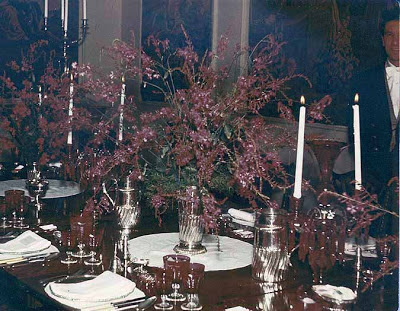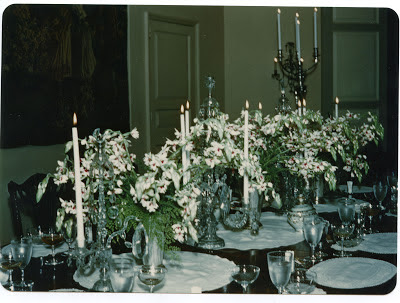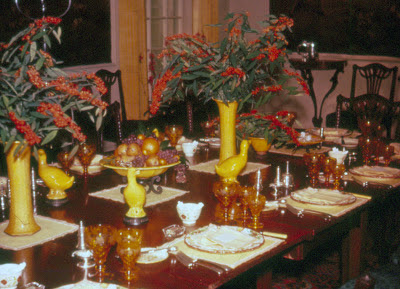November 05, 2012
Dining with Mr. du Pont
A 1956 dinner party at Winterthur
Winterthur (the thur pronounced with a hard T!) is a house museum I never tire of visiting. While its collection of American decorative arts is top notch, it is the house as a whole - a spectacular, precious document of a certain rarefied way of 20th century life that has all but evaporated - that I find so compelling. The museum takes pains to maintain the seasonal changes, from curtains to slip-covers, that were in place during the day of its owner Henry Francis du Pont and lucky us - for the result is the feeling that time has stood still and we are back in there halcyon days.
du Pont took entertaining seriously and an evening's arrangements were rigorously planned with military precision. His daughter Ruth Lord recalled in Henry F. du Pont and Wintherthur, "In the huge china closet, whose shelves were loaded with stacks of dishes, a footman would climb a ladder and perilously hand down several centerpieces and matching plates. My father and the butler would then decide on the combination of china, glass, and linen that would best complement the flowers . . . Guests were not permitted to see the room before 8:30, when-with the butler's announcement of dinner-the curtain went up."
I got a special glimpse of du Pont's artistry at Winterthur's annual Chic it Up symposium this fall. Besides special lectures by speakers who are both erudite and engrossing, there are a selection of workshops which take you behind the scenes of the collection. (Let me tell you, you haven't lived until you've gone into the curtain room where all the off-season curtains are stored - unless you too have a set for each season for your 100+ room house.)
Meredith Graves, the coordinator of the museum's flower program, gave us some insights into du Pont's own taste and how the house today continues the tradition of fresh arrangements in many of the rooms. (At Christmas time, Meredith and her team decorate a soaring Yuletide tree with masses of flowers used throughout the year which have been dried and preserved in the meantime.)
As many from Edouard Vuillard to John Fowler would agree, du Pont remarked that "... color is the thing that really counts more than any other" and it was around this guiding inspiration that his table schemes evolved, starting with flowers collected from du Pont's own gardens and hothouses on the property. Maurice Gilliand, the Winterthur butler from 1944 to 1951, noted, "On the estate, Mr. du Pont was known as the Head Gardener, in his house he was known as the Head Butler." With his tables, he combined both roles.
Because of the custom of speaking only to your dinner partner on one's left during one course and then on the right during another, low squat arrangements weren't necessary. Depending on the size of the dinner party, a number of cascading bouquets paraded down the table's center at eye level. In fact, creating a wall of sorts down the middle created intimacy. The museum has a record of many of these arrangements as du Pont meticulously documented his favorite table settings.
Close up of table setting showing assortment of table glass, including finger bowls*
No detail or effort was spared - one imagines that du Pont took as much pleasure in the planning and plotting as his guests did in the unveiling. Maggie Lidz, Winterthur's historian, discovered that du Pont commissioned artist Marshall Fry to hand-dye and crochet the table linens to complement the china. Maggie notes, "Du Pont was so fond of them, he worried about their fate after his death. He instructed his executors, "The colored mats and napkins are not to be sent to a public laundry. With careful washing they have kept their colors for many years. I do not want them spoiled. They were made by Marshall Fry of Southampton and are in themselves well worth preserving."
This year's Delaware Antiques Show (running November 9 - 11) will present a special loan exhibition dedicated to du Pont's firecracker table displays. On Sunday, the 11th, Maggie will lecture on his legendary entertaining. For details on this and other lectures at the show, click here.
All photos courtesy of Winterthur. With many thanks to Maggie Lidz for her help in compiling this post. I also heartily recommend her book The du Ponts: Houses and Gardens in the Brandywine.*
Click here to read Maggie's post about the "dotty" glassware
















